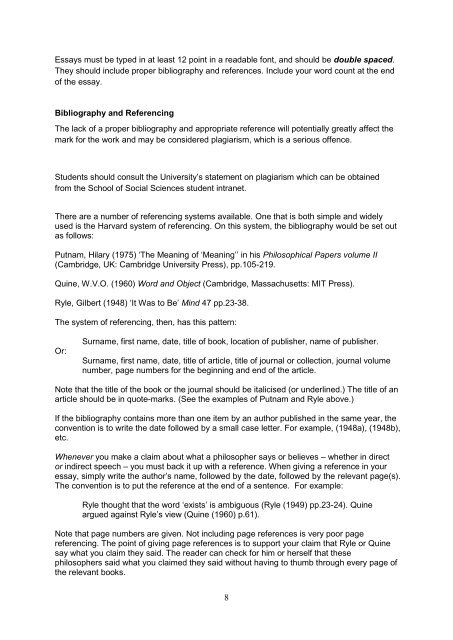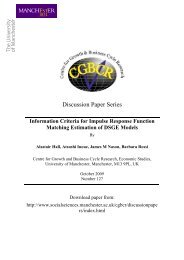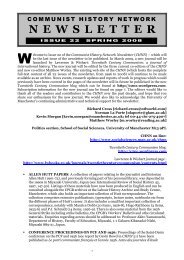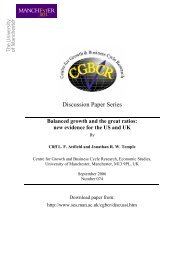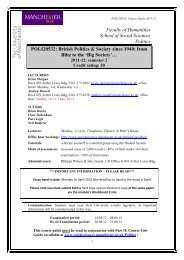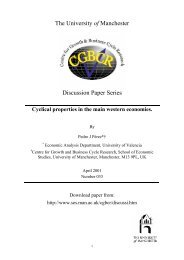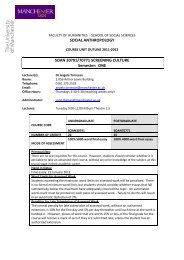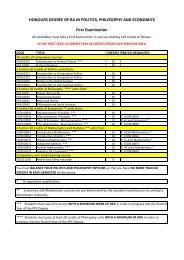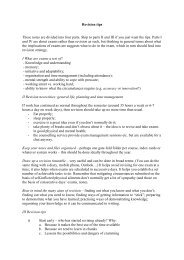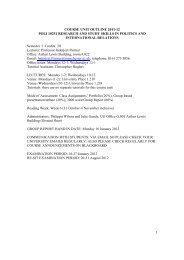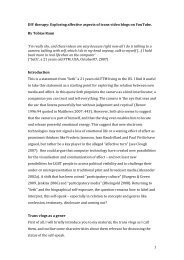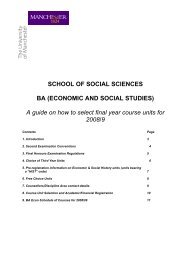second year course outlines 2012-2013 - School of Social Sciences ...
second year course outlines 2012-2013 - School of Social Sciences ...
second year course outlines 2012-2013 - School of Social Sciences ...
Create successful ePaper yourself
Turn your PDF publications into a flip-book with our unique Google optimized e-Paper software.
Essays must be typed in at least 12 point in a readable font, and should be double spaced.<br />
They should include proper bibliography and references. Include your word count at the end<br />
<strong>of</strong> the essay.<br />
Bibliography and Referencing<br />
The lack <strong>of</strong> a proper bibliography and appropriate reference will potentially greatly affect the<br />
mark for the work and may be considered plagiarism, which is a serious <strong>of</strong>fence.<br />
Students should consult the University’s statement on plagiarism which can be obtained<br />
from the <strong>School</strong> <strong>of</strong> <strong>Social</strong> <strong>Sciences</strong> student intranet.<br />
There are a number <strong>of</strong> referencing systems available. One that is both simple and widely<br />
used is the Harvard system <strong>of</strong> referencing. On this system, the bibliography would be set out<br />
as follows:<br />
Putnam, Hilary (1975) ‘The Meaning <strong>of</strong> ‘Meaning’’ in his Philosophical Papers volume II<br />
(Cambridge, UK: Cambridge University Press), pp.105-219.<br />
Quine, W.V.O. (1960) Word and Object (Cambridge, Massachusetts: MIT Press).<br />
Ryle, Gilbert (1948) ‘It Was to Be’ Mind 47 pp.23-38.<br />
The system <strong>of</strong> referencing, then, has this pattern:<br />
Or:<br />
Surname, first name, date, title <strong>of</strong> book, location <strong>of</strong> publisher, name <strong>of</strong> publisher.<br />
Surname, first name, date, title <strong>of</strong> article, title <strong>of</strong> journal or collection, journal volume<br />
number, page numbers for the beginning and end <strong>of</strong> the article.<br />
Note that the title <strong>of</strong> the book or the journal should be italicised (or underlined.) The title <strong>of</strong> an<br />
article should be in quote-marks. (See the examples <strong>of</strong> Putnam and Ryle above.)<br />
If the bibliography contains more than one item by an author published in the same <strong>year</strong>, the<br />
convention is to write the date followed by a small case letter. For example, (1948a), (1948b),<br />
etc.<br />
Whenever you make a claim about what a philosopher says or believes – whether in direct<br />
or indirect speech – you must back it up with a reference. When giving a reference in your<br />
essay, simply write the author’s name, followed by the date, followed by the relevant page(s).<br />
The convention is to put the reference at the end <strong>of</strong> a sentence. For example:<br />
Ryle thought that the word ‘exists’ is ambiguous (Ryle (1949) pp.23-24). Quine<br />
argued against Ryle’s view (Quine (1960) p.61).<br />
Note that page numbers are given. Not including page references is very poor page<br />
referencing. The point <strong>of</strong> giving page references is to support your claim that Ryle or Quine<br />
say what you claim they said. The reader can check for him or herself that these<br />
philosophers said what you claimed they said without having to thumb through every page <strong>of</strong><br />
the relevant books.<br />
8


